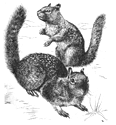Vertebrate Pest Conference: Proceedings

Vertebrate Pest Conference Proceedings: 7th (1976)
Date of this Version
March 1976
Document Type
Article
Abstract
A review of the literature reveals that over 60 chemicals have been used for the capture of wild animals, but only 30 of the most widely used chemicals are discussed in the present paper. For practical considerations these chemicals can be classified as being either (l) neuromuscular blocking agents, or (2) central nervous system (CNS) depressants. Some common neuromuscular blocking agents are d-tubocurarine, gallamine, succiny1choline, and nicotine. M99 and its derivatives, phencyclidine, and xylazine are some of the more commonly used CNS depressants. Neuromuscular blocking agents have a relatively rapid onset and short duration of action but they do not possess sedative, analgesic, or anesthetic properties. CNS depressants do produce desirable sedative, analgesic, and anesthetic effects, and frequently a combination of CNS depressants results in more desirable immobilization characteristics.

